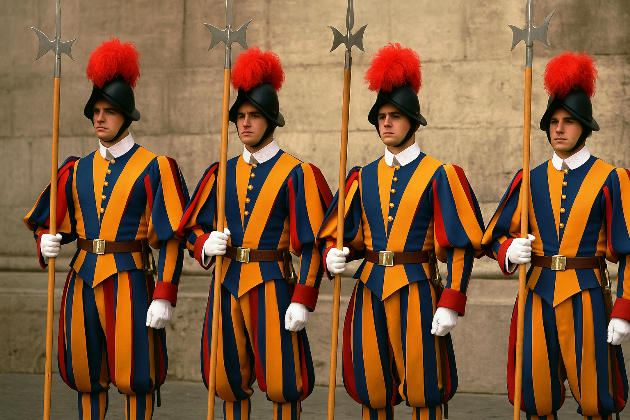The Swiss Guards – More Than a Colorful Uniform

The Swiss Guards: Soldiers of Faith, Defenders of the Pope
With their unmistakable Renaissance-style uniforms of blue, red, and gold, the Pontifical Swiss Guards are among the most recognizable figures in the Vatican. But behind their ceremonial appearance is a long, proud, and even heroic history of loyalty, sacrifice, and military readiness.
They are not just symbolic—they are the Pope’s personal army.
Let’s explore their origins, their purpose, and a moment in history when they defended the papacy with their very lives.
When Did the Swiss Guards Begin Protecting the Pope?
The Pontifical Swiss Guard was officially founded on January 22, 1506, by Pope Julius II, also known as “The Warrior Pope.” At that time, the papacy needed trustworthy soldiers to protect it from the many political and military threats of the Renaissance period.
Julius II turned to the Swiss Confederation, whose soldiers were famed across Europe for their discipline, loyalty, and fighting prowess. On that date, 150 Swiss mercenaries marched into Rome under the command of Captain Kaspar von Silenen, entering Vatican service—and they’ve never left.
Was There Always a Full Force of Swiss Guards?
The size of the Swiss Guard has fluctuated over time depending on political conditions and the needs of the Vatican. In modern times, the guard typically numbers around 135 men, all of whom must:
- Be Swiss citizens,
- Be Catholic,
- Be single and under 30 years of age,
- Have completed basic military training in Switzerland,
- Be of good moral standing and exemplary character.
While the Guard today focuses heavily on ceremonial duties and security, they are fully trained soldiers, skilled in modern defensive tactics—and still carry traditional halberds alongside modern firearms.
Have the Swiss Guards Ever Had to Defend the Pope in Battle?
Yes. The most famous and tragic moment in Swiss Guard history occurred on May 6, 1527, during the Sack of Rome by the troops of Emperor Charles V.
In a brutal and unexpected attack, tens of thousands of mutinous imperial troops—largely unpaid and hungry—stormed Rome and breached its walls. The Vatican was not spared. Pope Clement VII took refuge in Castel Sant’Angelo, connected to the Vatican by the Passetto di Borgo, a hidden elevated passageway.
As the enemy soldiers closed in, 189 Swiss Guards stood between the Pope and certain death. In a last stand at St. Peter’s Basilica, 147 of them were killed defending the Pontiff. Their sacrifice gave Clement VII enough time to escape to safety.
Only 42 survived.
Why Do They Still Serve Today?
That act of supreme loyalty in 1527 forged the reputation of the Swiss Guard as defenders of the Pope at all costs. Since then, they have served every pope continuously, adapting their responsibilities to the needs of the times.
Today, their duties include:
- Guarding Vatican entrances and papal residences,
- Providing security during papal Masses and public appearances,
- Protecting the Pope on international visits,
- Serving as a visible reminder of honor, tradition, and unwavering service.
Why the Colorful Uniform?
Though often attributed to Michelangelo, the current uniform was actually designed by Commandant Jules Repond in 1914, inspired by Renaissance frescoes of Swiss Guards from earlier centuries. The colors—blue, red, and yellow—are the colors of the Medici family, to which Pope Clement VII belonged.
But don’t be fooled by the pageantry—their uniforms are hand-tailored, but their training is elite.
A Living Legacy
Each year on May 6, the anniversary of the 1527 battle, new recruits take an oath in the Courtyard of St. Damasus—pledging to protect the Pope, even with their lives.
Their motto remains:
“Acriter et Fideliter” – Courageously and Faithfully.
So next time you see a Swiss Guard standing silently at a Vatican gate, remember:
He is not just a ceremonial guard—he is part of a centuries-old brotherhood of soldiers who have bled, fought, and served to protect the Vicar of Christ.






